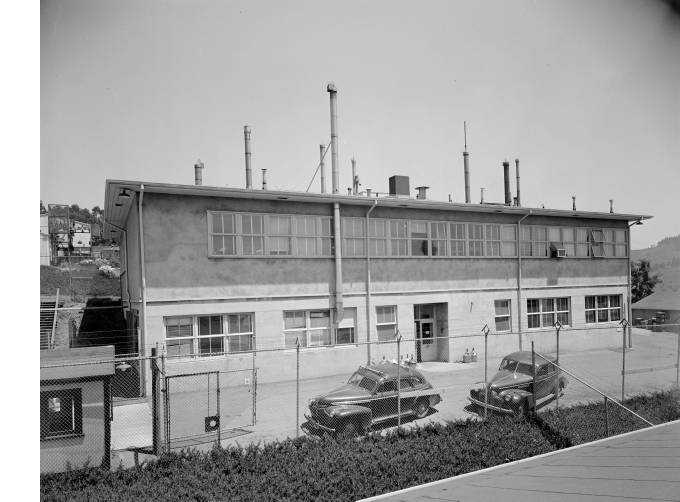Contact: Julie Chao
Sitting exactly at the center of the Lawrence Berkeley National Laboratory site is a cluster of nondescript low-rise buildings known as Old Town. It had its heyday in the post-World War II years, when Harry Truman was president and America was locked in a nuclear weapons race with the Soviet Union. Of course it wasn’t called Old Town in those days. It was the Lab, known back then as the Radiation Laboratory, or the Rad Lab, where Ernest Orlando Lawrence and “Lawrence’s boys” conducted groundbreaking physics experiments and would go on to win eight Nobel Prizes.
Fast-forward 60 years. Berkeley Lab has grown to 200 acres and 4,000 employees. Modern new buildings have gone up, housing state-of-the-art laboratories for the Lab’s cutting-edge science programs, not only in physics and chemistry but also in cancer research, genomics, advanced computing, and clean energies of just about every stripe. Meanwhile, many of the buildings in Old Town have fallen into disuse. Some are seismically inadequate. Today less than 150 people work in Old Town, half of them in one building. Other buildings are nearly empty.
Faced with a critical need for space coupled with a prime development opportunity in Old Town, Berkeley Lab decided to apply for $45 million in federal stimulus funding for demolition and remediation of the site and to prepare it for construction. The Department of Energy’s Office of Environmental Management was allocated $6 billion under the American Recovery and Reinvestment Act (ARRA) for clean-up of the national laboratories and nuclear weapons facilities. Under its proposal to the Office of Environmental Management, LBNL would demolish 14 buildings in Old Town, most built in the 1940s and 50s. The project would clear up about three acres of land for future development.
Political leaders in the Bay Area and state have expressed support for the proposal. Governor Arnold Schwarzenegger and Representative Barbara Lee have written to Secretary of Energy Steven Chu and Berkeley Mayor Tom Bates and Oakland Mayor Ron Dellums sent Chu a joint letter. “The Laboratory plays a critical role in our region’s, our state’s and indeed our nation’s scientific enterprise particularly relating to energy security and efficiency,” states the letter from Bates and Dellums. “It is critical that the Lawrence Berkeley National Laboratory be able to both clean up from past uses and prepare the site for years to come.”
Research teams across Berkeley Lab are investigating multiple areas of sustainable energy, including building and energy efficiency, batteries, carbon capture and sequestration, photovoltaics and artificial photosynthesis. “Growth in our science programs has resulted in a serious space crunch at Berkeley Lab,” said Chief Operating Officer Jim Krupnick. “Our existing buildings are at maximum capacity. Renewing Old Town would provide our scientists with the equipment and opportunities for collaboration needed for real advances in their work.”
So far, DOE has allocated more than $130 million in ARRA funding to Berkeley Lab, much of it for construction and infrastructure upgrades. One of the ARRA allocations was $14.3 million for the demolition of the Bevatron which, during its operation from 1954 until 1993, was among the world’s leading particle accelerators.
Old Town has been in disuse for several decades. “It was already known as Old Town 30 years ago,” said Andy Sessler, Berkeley Lab’s director in the 1970s. “We tried to have it changed, tear down old shacks, put up new buildings or green fields, but we just couldn’t get any support for these activities.”
The first electron synchrotron was developed in Old Town by Edwin McMillan, who shared the 1951 Nobel Prize for chemistry with Glenn Seaborg for the discovery of several transuranium elements. Lawrence, the Lab’s namesake, and his team played a role in the Manhattan Project, developing a means of electromagnetic separation of uranium. Post-war accomplishments at Old Town were numerous: scientists used the Rad Lab’s new 184-inch synchrocyclotron to essentially launch the field of modern nuclear medicine; biochemist Melvin Calvin deciphered the process of photosynthesis, resulting in the 1961 Nobel Prize for chemistry.
The Berkeley Lab has been conducting an environmental cleanup program at the Old Town site since 2005, addressing issues of soil and groundwater contamination. Contaminants have been reduced significantly; additional funding would allow remediation in previously inaccessible areas beneath the buildings.
Demolishing Old Town and building on the site would have environmental benefits in more than one way. “LBNL takes seriously our responsibility to be environmental stewards of our site,” said Interim Lab Director Paul Alivisatos. “Cleaning up Old Town will relieve the pressure of having to build in green-fill areas and give us prime land to develop modern facilities for conducting next-generation science.”
